Abstract
A self-assembled MnO2/Mxene composite film was compounded with MXene nanosheets and layered crystalized MnO2 nanosheets using surfactant sodium dodecyl sulfate (SDS) as a soft template. The obtained material was characterized by XRD, SEM, XPS, and FT-IR, which showed that the films have large surface-active functional groups and metal ion flow channels, indicating that the MnO2/Mxene composite films were capable of both the chemical and physical adsorption of the target heavy metal ions. The analysis of adsorption performance showed that the Pb2+ removal rate reached 98.3% at pH 6 and an initial Pb2+ concentration of 30 mg/L, while the maximum adsorption capacity could reach 1235 µmol/g. In addition, the MnO2/Mxene composite film had specific selectivity and recyclability. The reuse study verified that the Pb2+ removal rate reached 96.4% after five cycles, confirming that the MnO2/Mxene composite films had practical application prospects.
1. Introduction
The presence of heavy metal ions (e.g., Pb2+, As3+, Cu2+) in water poses a significant threat to human health through food chain transfers due to their toxicity and the tendency for bioaccumulation. Several approaches have been developed and used to remove aqueous heavy metals, such as adsorption, membrane separation, precipitation, ion exchange, photocatalysis, and electrochemical removal [1,2,3,4,5]. These commonly used technologies have some specific advantages as well as some inherent disadvantages. For example, precipitation is very effective and simple to operate, but the process generates a large amount of sludge, leading to secondary pollutants. Membrane separation, ion exchange, and electrochemical removal have the advantages of high efficiency and selectivity. However, they all have very high operation costs, while membrane and ion exchange also make regeneration difficult [6,7,8]. Of these methods, adsorption is considered one of the most efficient and effective means of removing heavy metal ions; it also has a good tolerance for a wide range of pH values and can be easily operated [9]. Currently, cheap and readily available carbon-based materials are widely used for the adsorption of heavy metal ions [10,11,12], but their adsorption capacity is not ideal due to the limited specific surface area. Moreover, the adsorption of heavy metal ions is not selective, so that other metal ions can easily interfere in the process owing to competitive adsorption effects.
Metal oxides, especially manganese oxide, show strong adsorption properties for metal ions due to their highly active sites. Their adsorption capacities are higher than carbon-based materials due to physical and chemical adsorption [13,14,15]. For example, Ma Jun et al. compounded graphene with δ-MnO2 and used it as an adsorbent to remove Pb2+ and Cu2+ from water. The maximum adsorption capacity could reach 781 µmol/g and 1620 µmol/g, respectively, where Pb2+ and Cu2+ could be adsorbed on the surface of the composite and enter the inter-layers of MnO2 to cause adsorption [12]. Eun-Ju Kim et al. synthesized a three-dimensional MnO2 loaded with magnetic Fe3O4 by a hydrothermal method, and its maximum adsorption capacity for Cd is 53.2 mg/g. In addition, the adsorption rate for different metal ions follower the order Cu(II) > Pb(II) > Cd(II) > Zn(II) [16]. However, the following problems exist when using manganese oxide as an adsorbent for heavy metal ions, making it a challenge to meet the needs of practical applications. First, the adsorption effect of manganese oxide is often disturbed by other cations in the solution, and the selective adsorption characteristics are not prominent. Second, manganese oxide has good dispersibility, which facilitates adsorption but makes recycling difficult.
MXene is a carbon-based compound with a two-dimensional crystal structure obtained by etching an intermediate metal layer from the MAX phase material. Due to its typical layered structure and rich surface characteristics, MXene shows excellent adsorption properties for heavy metal ions and organic pollutants [17,18,19,20,21]. Unlike other carbon-based adsorbents, MXene can selectively adsorb metal ions from water. For instance, the selective adsorption properties of two-dimensional titanium carbide on Pb2+ were investigated by Tian Yongjun et al. Their results showed that the hydroxyl functional group on the surface of titanium carbide gives it excellent selective adsorption properties for Pb2+, even if high concentrations of Mg2+ or Ca2+ cations existing in the solution [22].
In this paper, a wet-chemistry method was used to synthesize monolayer manganese oxide nanosheets under the induction of surfactants. Moreover, MXene, which is currently on the cutting edge of material science research, was applied to modify and functionalize the MnO2 nanosheet to tackle the difficulties mentioned above and improve the selectivity and regeneration ability of the absorbent. Therefore, monolayer MnO2 nanosheets were self-assembled layer by layer with MXene nanosheets to form a self-supporting MnO2/MXene composite film and then used for the selective adsorption of Pb2+. The adsorption characteristics of the MnO2/MXene composite film were systematically investigated with various experimental parameters, such as solution pH value, adsorption time, and initial metal ion concentration. Meanwhile, the removal rate of Pb2+ over five cycles and the effects of other metal cations on the adsorption properties of Pb2+ were also investigated. The results proved that the MnO2/MXene composite film has a high adsorption capacity and some degree of adsorption selectivity and stability for Pb2+. It also has the advantages of being easy to recycle and reuse.
2. Materials and Methods
2.1. Synthesis of Monolayer Manganese Oxide Nanosheets
Three grams of SDS powder was dissolved in 100 mL of deionized water, magnetically stirred well; then, 1.5 mL of H2SO4 was added and stirred to obtain a clear and transparent solution. Afterward, the solution was heated and stirred in an oil bath at 90 °C for 15 min and 0.8 g of KMnO4 powder was added, and the reaction was performed at that temperature for 1 h. Finally, the mixture was cooled and washed with deionized water to remove excess surfactant and freeze-dried to obtain the monolayer MnO2 nanosheets [23].
2.2. Preparation of MnO2/MXene Composite Films
Ten milligrams of the above single-layer MnO2 nanosheets were weighed and dispersed in 100 mL of deionized water; then, 2 mg of commercially available MXene solution was added, and after ultrasonic dispersion for 30 min, vacuum filtration was performed to obtain a MnO2/MXene composite self-supporting film [24].
2.3. Characterization Test
Field emission scanning electron microscope (SEM, Zeiss SIGMA, Carl Zeiss AG, Jena, Germany), and transmission electron microscope (TEM, JEM-2100, JEOL, Tokyo, Japan) were applied for the morphological characterization of the MnO2/MXene composite film, while the X-ray diffraction patterns were recorded on the X-ray diffractometer (XRD, XPert Pro, PANalytical Corporation, Malvern, UK) and fully automatic rapid comparison on the Surface area and porosity analyzer (BET, ASAP 2020, McMerritik (Shanghai) Instrument Co., Ltd., Shanghai, China) The photoelectron spectra were recorded on X-ray photoelectron spectrometer (XPS, ESCALAB 250Xi, Thermo Fisher, Waltham, MA, USA), continuous light source atomic absorption spectrometer (contrAA700, Analytik Jena AG, Thuringia, Germany), while the IR spectra were recorded on a Thermo FT-IR 5700 IR spectrometer (KBr).
2.4. Heavy Metal Ion Adsorption Test
To start, 30 mg/L Pb2+ solution was taken as the target heavy metal ion solution, and 12 mg of MnO2/MXene composite film was weighed and placed in 100 mL of Pb2+-containing solution as the pH value was adjusted from 3 to 7, and adsorption equilibrium was reached by stirring at a low speed at room temperature. Atomic absorption spectrometry was used to measure the changes in the concentration of heavy metal ions (Pb2+) in different pH environments and at different adsorption times, and the adsorption capacity and removal rate were calculated. In addition, the adsorption characteristics of MnO2/MXene composite films were also investigated when the solution pH was 6 and the initial concentration of Pb2+ was from 10 to 90 mg/L to evaluate the influence of different initial concentrations on the adsorption efficiency of the films.
Adsorption capacity was calculated by using the mass balance equation for the adsorption (1):
In addition, the removal rate (%) was calculated from the Equation (2):
where is the adsorption capacity (mg/g) at equilibrium, and are the initial and the equilibrium concentrations (mg/L), respectively, is the volume (L) of the solution, and is the mass (g) of the adsorbent used [25].
3. Results
3.1. Morphology and Structure Characterization
Figure 1A–C shows the cross-sectional and surface SEM images of the commercially available MXene solution after filtration. As MXene has a typical two-dimensional nanosheet structure, a layer-by-layer self-assembled film can be formed by suction filtration. What can be seen from Figure 1C is that the surface of MXene still maintains a good nanosheet morphology after suction filtration. Figure 1D–E shows the cross-sectional SEM images of the MnO2/Mxene composite films, with the self-assembled films obtained by filtration after the addition of MnO2 nanosheets. In comparison with the cross-sectional figures of the MXene films, it can be seen that the stacking of nanosheets in the MnO2/MXene composite films is more fluffy; this provides more adsorption sites than the dense MXene films and is more conducive to the flow and adsorption of metal ions between the nanosheet layers. In addition, the cross-sectional surface sweep result of the MnO2/MXene composite films shows that all the elements can be uniformly distributed in the composite films (as shown in Figure 1F), indicating that MnO2 and MXene are alternately stacked. In addition, Ti and C were derived from MXene (TiC), Mn and O originated from MnO2 nanosheets, while K was introduced by the MnO2 preparation process and was present between the lattice layers of MnO2, supporting its layered crystal structure and maintaining charge balance.
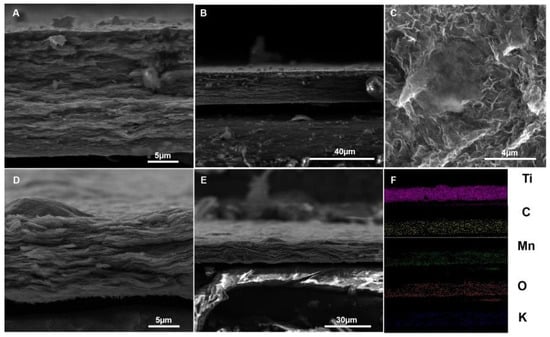
Figure 1.
(A–C) SEM images of the cross-section and surface of the commercially available MXene solution after suction filtration. (D,E) SEM images of the cross-section of the MnO2/MXene composite film. (F) Element distribution in the MnO2/MXene composite film.
Figure 2 shows the XRD pattern of the MnO2/MXene composite film. The peaks at 5.6° and 27.1° are characteristic of 2D Ti3C2, where 5.6° corresponds to the crystal plane (002), indicating a layer spacing of 1.56 nm for Ti3C2. Similarly, 17.1°, 29.2°, and 36.3° correspond to the characteristic peaks of 2D MnO2. No characteristic peaks of other heterogeneous phases were observed, indicating that the prepared material was the pure-phase MnO2/Mxene composite.
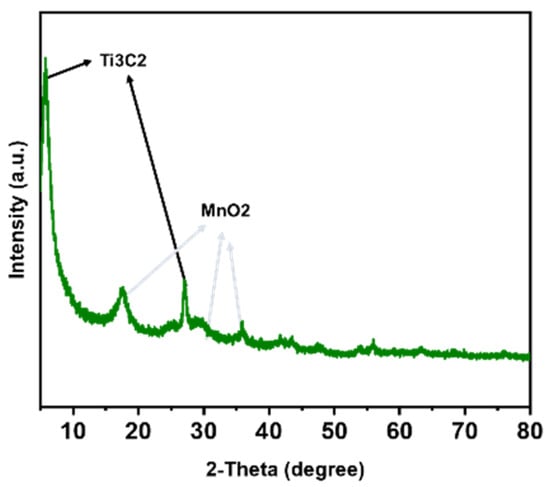
Figure 2.
XRD patterns of MnO2/MXene composite films.
Furthermore, the XPS of the MXene, MnO2, and MnO2/MXene composite films were tested to characterize their surface or near-surface valence information. For MXene (Figure 3), it is evident from the XPS pattern that it contains a certain amount of O and F in addition to the elements Ti and C. More specifically, for Ti2p, the characteristic peaks consist of Ti-O-Ti, Ti-OH, and Ti-C, while those of C1s are derived from C impurities introduced during the testing process in addition to Ti-C and C-OH, and the characteristic peaks of O1s consist of Ti-O-Ti, Ti-OH, and C-OH. The above test results indicate that the surface of MXene contains a large amount of surface functional groups, such as C-OH, Ti-OH, and F−, which are all capable of bonding heavy metal ions in water to achieve efficient adsorption. The surface valence properties of the prepared MnO2 nanosheets were characterized by XPS, as shown in Figure 4, where the characteristic peak of Mn2p indicates that the surface is composed of Mn3+ and Mn4+. The presence of Mn3+ makes the surface of MnO2 negatively charged and causes oxygen defects, which is beneficial for the adsorption of positively charged metal cations in solution to achieve charge balance. The O1s characteristic peak, on the other hand, consists of Mn-O-Mn, Mn-OH, and the adsorbed water on the surface. As shown in Figure 5, after compounding, the MnO2/Mxene composite film results in the characteristic peaks of both MXene and MnO2. Therefore, it has the surface properties of both MXene and MnO2.

Figure 3.
XPS spectra of MXene: (A) is O1s, (B) is Ti2p, and (C) is F1s.
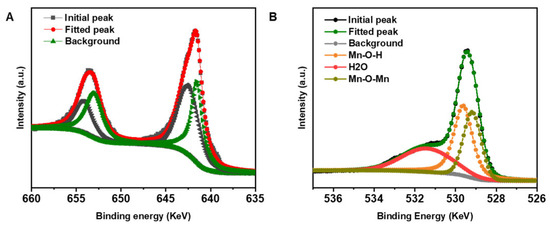
Figure 4.
XPS spectrum of MnO2: (A) is Mn2p and (B) is O1s.
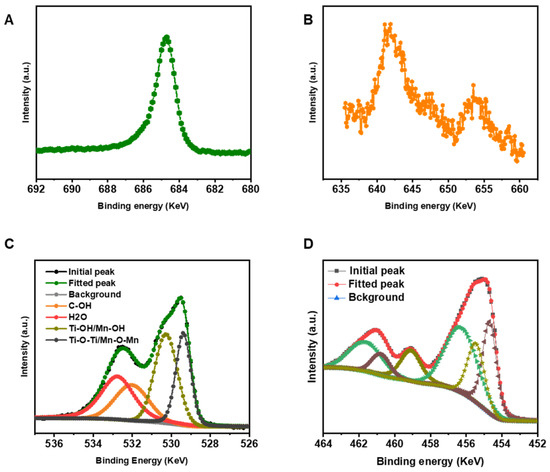
Figure 5.
XPS spectrum of MnO2/MXene composite films: (A) is F1s, (B) is Mn2p, (C) is O1s, and (D) is Ti2p.
As shown in the FT-IR spectrum (Figure 6), the wide bands at 1640 and 3292 cm−1 in the MnO2/MXene composite film represents the bending vibration of water molecules and the O-H contraction vibration of water molecules, respectively, while the characteristic peaks of Mn-O and Ti-C are found between 600 and 700 cm−1 [26].
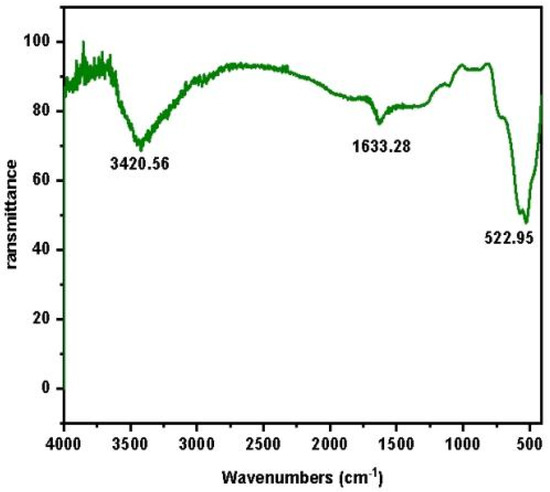
Figure 6.
FT-IR spectrum of MnO2/MXene composite films.
3.2. Study of Adsorption Performance
The above characterizations show that the synthesis of MnO2 nanosheets using surfactants as soft templates and their composites with MXene nanosheets can self-assemble into thin films, which combines the surface properties of MnO2 and MXene with abundant surface active sites. In addition, both MnO2 and MXene are typical two-dimensional crystalline structures with large layer spacing; indeed, the layer spacing of MXene can reach 1.56 nm, which provides more adsorption channels for metal ion adsorption. Moreover, the microscopic morphology of the stacked layers can also provide adsorption channels for metal ions (Figure 7).
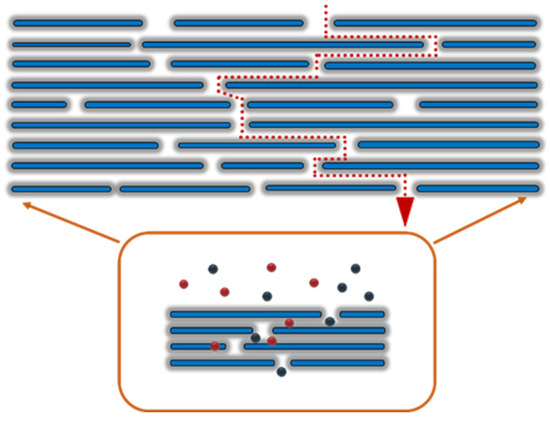
Figure 7.
Schematic diagram of adsorption of heavy metal ions by MnO2/MXene composite film [27].
3.2.1. Effect of pH on Adsorption Performance
Figure 8 shows the adsorption characteristics of the MnO2/Mxene composite film at different pH values. It can be seen that the MnO2/Mxene composite film can be used in a wide range of pH solutions, and that the removal rate of Pb2+ increases as the pH value rises. The removal rate was 28.3% when the pH was 3 and leveled off at pH 6 (reaching 98.3%), indicating that the pH of the solution has a significant effect on the adsorption of Pb2+. As the surface of the MnO2/Mxene composite film has abundant -OH groups, the negative charge on its surface increases as the pH value increases. Therefore, at low pH values, the adsorption of Pb2+ is low and gradually increases with the increase in pH value as H+ in solution competes for the adsorption of -OH on the surface of the MnO2/Mxene composite film.
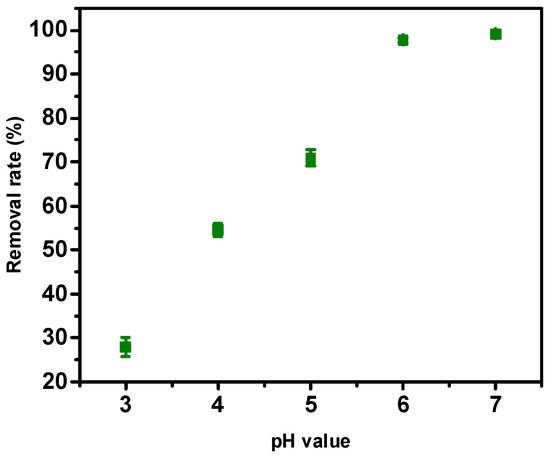
Figure 8.
Removal rate of Pb2+ under different pH values. (Experimental conditions: MnO2/Mxene composite films 12 mg, solution volume 100 mL = 30 mg/L, 25 °C).
3.2.2. Effect of Adsorption Time on Adsorption Performance
The adsorption kinetics experiments of MnO2/MXene composite films were investigated when the solution pH was 6 (Figure 9). The removal of Pb2+ was only 27.4% within the initial hour. However, the removal increased to 98.3% after 8 h of reaction and reached adsorption equilibrium. Compared to other conventional powder adsorbents, the MnO2/MXene composite film took longer to reach adsorption saturation due to the lower specific surface area of the MnO2/MXene composite film, which exposed a smaller amount of metal ions in a short period. However, over time, heavy metal ions were able to flow in the inter-layer channels of the MnO2/MXene composite film and achieve the adsorption of metal ions. Therefore, although the time to achieve adsorption equilibrium was prolonged, the MnO2/MXene composite film still had a high Pb2+ removal rate. Furthermore, the longer adsorption equilibrium time also indicated that the chemical adsorption mechanism plays a decisive role in the adsorption rate of the reaction during the adsorption of Pb2+ by the MnO2/Mxene composite film.
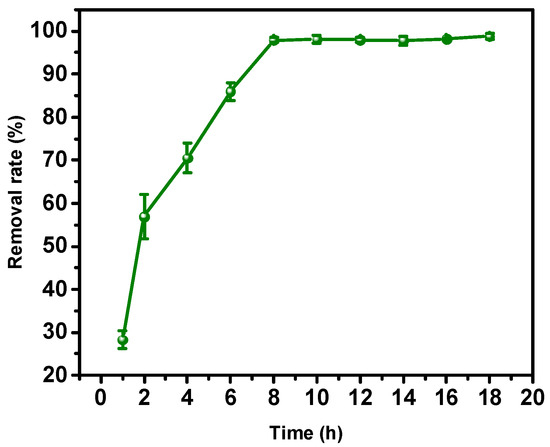
Figure 9.
The removal rate of Pb2+ at different adsorption times. (Experimental conditions: pH = 6, MnO2/Mxene composite films 12 mg, solution volume 100 mL, = 30 mg/L, 25 °C).
3.2.3. Effect of Initial Concentration on the Adsorption Capacity
Figure 10 explores the effect of the initial concentration on the adsorption capacity when the pH is 6. The MnO2/MXene composite film adsorption capacity was 401.4 µmol/g when the initial concentration of Pb2+ was 10 mg/L and reached 1187 µmol/g at 30 mg/L and 1235 µmol/g at 90 mg/L. As the initial concentration of Pb2+ continued to increase, the adsorption capacity did not increase significantly. The excellent adsorption properties of MnO2/MXene composite films can be attributed to two factors. First, the -OH, F− and defects on the surface of the MnO2/Mxene composite film can act as ligands for metal ions, thus achieving chemical complex adsorption. Second, the MnO2/Mxene composite film has a layered crystal structure, and its layer spacing and two-dimensional channels formed by layer stacking further provide adsorption sites.

Figure 10.
The adsorption capacity of Pb2+ under different initial concentrations. (Experimental conditions: pH = 6, MnO2/Mxene composite films 12 mg, solution volume 100 mL, 25 °C).
3.2.4. Cycling Performance Test of Mno2/Mxene Composite Film
In addition, MnO2/Mxene composite films can easily be recycled after use for heavy metal ion adsorption. Compared with traditional powder adsorbents, film-based adsorbents do not possess advantages in terms of adsorption time, but can be easily recycled without causing secondary contamination of water bodies. After the adsorption test, the MnO2/Mxene composite film was regenerated to verify its recycling characteristics. As shown in Figure 11, the Pb2+ removal rate remained at 96.4% after five cycles, and the adsorption performance was only 1.9% lower than the first adsorption, demonstrating the excellent stability of the material to cycling.
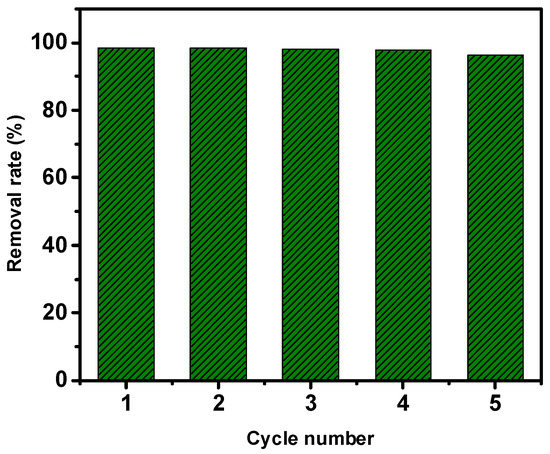
Figure 11.
The removal rate of Pb2+ during cycling. (Experimental conditions: pH = 6, MnO2/Mxene composite films 12 mg, solution volume 100 mL = 30 mg/L, 25 °C).
3.2.5. The Effect of Other Metal Cations on the Adsorption Performance
Actual industrial wastewater contains large amounts of heavy metal ions and other metal cations, such as Mg2+, Ca2+, and K+. These unavoidable cations can interfere with the adsorption of Pb2+ and affect the adsorption capacity. In order to explore the effect of other metal cations on the adsorption performance of Pb2+ by MnO2/Mxene composite films, a mixed solution containing both Mg2+ and Pb2+ was served as the target solution to determine the adsorption characteristics at different Mg2+ contents. The concentration of Pb2+ in the fixed mixed solution was 30 mg/L. As shown in Figure 12, the Pb2+ removal rate decreased as the concentration of Mg2+ increased in the mixed solution. Although the Mg2+ content was much larger than that of Pb2+, showing that the MnO2/Mxene composite film still had excellent adsorption characteristics for Pb2+. For example, when the concentration ratio of Mg2+/Pb2+ was 10:1, the removal rate of Pb2+ could still reach 61.7%. This result indicated that although there was a certain degree of competition of Mg2+ on the adsorption of Pb2+, the MnO2/MXene composite film retains a selectivity for the adsorption of Pb2+, proving its promising prospects for practical wastewater treatment applications.
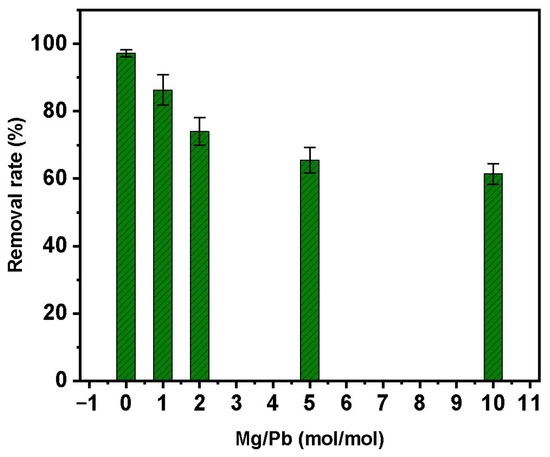
Figure 12.
Pb2+ removal rate at different concentrations of Mg2+. (Experimental conditions: pH = 6, MnO2/Mxene composite films 12 mg, solution volume 100 mL, = 30 mg/L, 25 °C).
3.2.6. Adsorption Kinetic of MnO2/Mxene Composite Films
The modeling of adsorption kinetics was conducted by using pseudo-second-order models with linear fitting (Figure 13):
where k is the pseudo-second-order adsorption rate constant (g · mmol−1 · min−1); t is the adsorption time, qe and qt are the adsorption rate (mmol · g−1) at equilibrium and at time t, respectively.
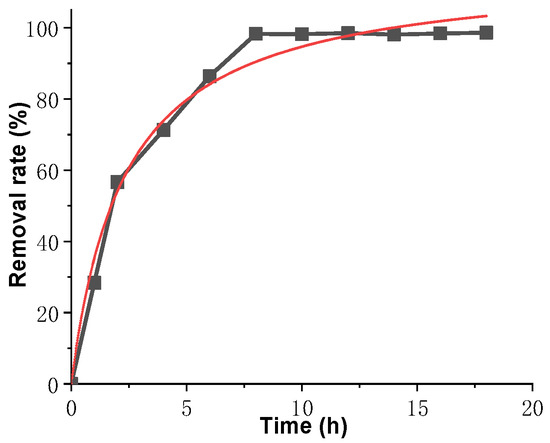
Figure 13.
Pseudo-second-order models with linear fitting.
According to the Table 1 and Figure 13, the mechanism of the adsorption contains both physical adsorption and chemical adsorption, and the long adsorption equilibrium time also indicates that the MnO2/MXene composite film on Pb2+ is the chemical adsorption mechanism plays a decisive role in the adsorption rate of the reaction.

Table 1.
Kinetic parameters for the pseudo-second-order models for the adsorption.
3.2.7. Comparison of Various MnO2-Based Adsorbents for Pb(II)
The comparison of the maximum adsorption capacities of the obtained MnO2/MXene composite films and various MnO2-based adsorbents for Pb2+ is listed in Table 2, which shows that the MnO2/MXene composite films might be an ideal adsorbent for aqueous Pb(II).

Table 2.
Comparison of the maximum adsorption capacities of various MnO2-based adsorbents for Pb(II).
4. Conclusions
In this paper, the MnO2/Mxene composite films were prepared by a layer-by-layer self-assembly process using SDS as a soft template and applied to the adsorption of Pb2+ in water. The effects of solution pH, adsorption time, initial concentration, and impurity ions on the adsorption of Pb2+ were investigated.
- (1)
- The pH value of the solution, adsorption time, and initial concentration all significantly affect the adsorption of Pb2+. The removal of Pb2+ by the MnO2/Mxene composite film reached 98.3% at pH 6 and reached adsorption equilibrium at 8 h. Increasing the content of Pb2+ in the initial solution can enhance the adsorption capacity of the MnO2/Mxene composite film, which reached 1235 µmol/g when the initial concentration of Pb2+ was 90 mg/L.
- (2)
- The MnO2/MXene composite film has a particular selectivity for Pb2+ adsorption, and the removal rate of Pb2+ can still reach 61.7% in the solution with high Mg2+ content (Mg2+/Pb2+ = 10:1).
- (3)
- The MnO2/Mxene composite film has the property of easy recovery; after five cycles of testing, its Pb2+ removal rate can still reach 96.4%.
- (4)
- The process of Pb2+ adsorption of by the MnO2/Mxene composite film is consistent with the pseudo-second-order models.
Author Contributions
H.Q.; writing—original draft preparation, J.D.; writing—review and editing, D.P.; investigation; T.W.; investigation; H.Z.; investigation; R.P.; supervision. All authors have read and agreed to the published version of the manuscript.
Funding
This research received no external funding.
Conflicts of Interest
The authors declare no conflict of interest.
References
- Sunil, K.; Karunakaran, G.; Yadav, S.; Padaki, M.; Zadorozhnyy, V.; Pai, R.K. Al-Ti2O6 a mixed metal oxide based composite membrane: A unique membrane for removal of heavy metals. Chem. Eng. J. 2018, 348, 678–684. [Google Scholar] [CrossRef]
- Xu, L.; Wang, T.; Wang, J.; Lu, A. Occurrence, speciation and transportation of heavy metals in 9 coastal rivers from watershed of Laizhou Bay, China. Chemosphere 2017, 173, e61–e68. [Google Scholar] [CrossRef] [PubMed]
- Xu, Y.; Zhang, C.; Zhao, M.; Rong, H.; Zhang, K.; Chen, Q. Comparison of bioleaching and electrokinetic remediation processes for removal of heavy metals from wastewater treatment sludge. Chemosphere 2017, 168, e1152–e1157. [Google Scholar] [CrossRef]
- Sounthararajah, D.P.; Loganathan, P.; Kandasamy, J.; Vigneswaran, S. Removing heavy metals using permeable pavement system with a titanate nano-fibrous adsorbent column as a post treatment. Chemosphere 2017, 168, e467–e473. [Google Scholar] [CrossRef] [PubMed]
- Tag El-Din, A.F.; El-Khouly, M.E.; Elshehy, E.A.; Atia, A.A.; El-Said, W.A. Cellulose acetate assisted synthesis of worm-shaped mesopores of MgP ionexchanger for cesium ions removal from seawater. Microporous Mesoporous Mater. 2018, 265, 211–218. [Google Scholar] [CrossRef]
- Barakat, M.A. New trends in removing heavy metals from industrial wastewater. Arab. J. Chem. 2011, 4, 361–377. [Google Scholar] [CrossRef] [Green Version]
- Nguyen, T.A.H.; Ngo, H.H.; Guo, W.S.; Zhang, J.; Liang, S.; Yue, Q.Y.; Li, Q.; Nguyen, T.V. Applicability of agricultural waste and byproducts for adsorptive removal of heavy metals from wastewater. Bioresour. Technol. 2013, 148, 574–585. [Google Scholar] [CrossRef]
- Xu, J.; Cao, Z.; Zhang, Y.L.; Yuan, Z.L.; Lou, Z.M.; Xu, X.H.; Wang, X.K. A review of functionalized carbon nanotubes and graphene for heavy metal adsorption from water: Preparation, application, and mechanism. Chemosphere 2018, 195, 351–364. [Google Scholar] [CrossRef]
- Sarma, G.K.; Sen Gupta, S.; Bhattacharyya, K.G. Nanomaterials as versatile adsorbents for heavy metal ions in water: A review. Environ. Sci. Pollut. Res. 2019, 26, 6245–6278. [Google Scholar] [CrossRef]
- Yao, H.; Zhang, X.F.; Hu, Z.H. The advantages of Shanglu biochar for Pb ion adsorption. J. Shihezi Univ. (Nat. Sci.) 2021, 39, 668–673. [Google Scholar]
- Zhai, F.J.; Zhang, C.; Song, G.F.; Jiang, S.X.; Shan, B.Q.; Song, Z.X. The adsorption mechanism of kapok biochar on Cr(VI) in aqueous solution. Acta Sci. Circumstantiae 2021, 41, 1891–1900. [Google Scholar]
- Wei, Z.P.; Zhu, Y.L.; Zhao, C.T.; Tang, J.X.; Gao, Y.X.; Li, M.X. Research Advances on Biochar Adsorption Mechanism for Heavy Metals and its Application Technology. Chin. J. Soil Sci. 2020, 51, 741–747. [Google Scholar]
- Peng, R.C.; Li, H.; Chen, Y.T.; Ren, F.P.; Tian, F.Y.; Gu, Y.W.; Zhang, H.L.; Huang, X.R. Highly efficient and selectivity removal of heavy metal ions using single-layer NaxKyMnO2 nanosheet: A combination of experimental and theoretical study. Chemosphere 2021, 275, 130068. [Google Scholar] [CrossRef]
- Song, Y.Q.; Tan, Q.; Lin, B.Y.; Liao, L.; Zeng, C.; He, Z.Z.; Lin, B.Y.; Qiu, W.M. Controllable synthesis of MnO2 with different crystal structures and their adsorption activity for heavy metals. Inorg. Chem. Ind. 2018, 50, 40–42, 53. [Google Scholar]
- Peng, Q.; Guo, J.X.; Zhang, Q.R.; Xiang, J.Y.; Liu, B.Z.; Zhou, A.G.; Liu, R.P.; Tian, Y.J. Unique Lead Adsorption Behavior of Activated Hydroxyl Group in Two-Dimensional Titanium Carbide. J. Am. Chem. Soc. 2014, 136, 4113–4116. [Google Scholar] [CrossRef]
- Ma, C.X.; Huangfu, X.L.; Ma, J.; Huang, R.X.; He, Q.; Liu, C.H.; Zhou, J.; Jiang, J.; Zhu, Y.Y.; Huang, M.H. Deposition Kinetics of Nanosized Manganese Dioxide in Presence of Divalent Cations. China Water Wastewater 2018, 34, 31–35. [Google Scholar]
- Kim, E.J.; Lee, C.S.; Chang, Y.Y.; Chang, Y.S. Hierarchically Structured Manganese Oxide-Coated Magnetic Nanocomposites for the Efficient Removal of Heavy Metal Ions from Aqueous Systems. ACS Appl. Mater. Interfaces 2013, 5, 9628–9634. [Google Scholar] [CrossRef] [PubMed]
- Zhang, W.J.; Kou, M. Applications of two dimensional material MXene in water treatment. J. Mater. Eng. 2021, 49, 14–26. [Google Scholar]
- Hou, J.H.; Yang, M.Y.; Sun, A.; Cao, C.B. Application of MXenes and their composite materials in the field of environment. Fine. Chemicals. 2021, 38, 2422–2431. [Google Scholar]
- Fan, M.; Wang, L.; Zhang, Y.J.; Pei, C.; Chai, Z.; Shi, W. Research progress of MXene materials in radioactive element and heavy metal ion sequestration. Sci. Sin. Chim. 2019, 49, 27–38. [Google Scholar] [CrossRef]
- Leng, Y.Y.; Zhang, S.Y.; Zong, X.X.; Li, Y.F. Research Progress on New Low Dimensional Materials MXene. Chem. Adhes. 2016, 38, 450–454. [Google Scholar]
- Wan, H.; Nan, L.; Geng, H.; Zhang, W.; Shi, H. Green Synthesis of A Novel MXene–CS Composite Applied in Treatment of Cr(VI) Contaminated Aqueous Solution. Processes 2021, 9, 524. [Google Scholar] [CrossRef]
- Liu, Z.; Xu, K.; Sun, H.; Yin, S. One-Step Synthesis of Single-Layer MnO2 Nanosheets with Multi-Role Sodium Dodecyl Sulfate for High-Performance Pseudocapacitors. Small 2015, 11, 2182–2191. [Google Scholar] [CrossRef]
- Chen, S.; Xiang, Y.; Xu, W.; Peng, C. A novel MnO2/MXene composite prepared by electrostatic self-assembly and its use as an electrode for enhanced supercapacitive performance. Inorg. Chem. Front. 2019, 6, 199–208. [Google Scholar] [CrossRef]
- Dinh, V.P.; Le, N.C.; Nguyen, T.P.; Nguyen, N.T. Synthesis of α-MnO2 Nanomaterial from a Precursor γ-MnO2: Characterization and Comparative Adsorption of Pb(II) and Fe(III). J. Chem. 2016, 2016, 8285717. [Google Scholar] [CrossRef] [Green Version]
- Zhao, Q.N.; Li, X.L.; Zhu, J.F.; Jiao, H.Y.; Huang, J.X. Manganese Dioxide Morphology on Electrochemical Performance of Ti3C2TX@MnO2 Composites. J. Inorg. Mater. 2020, 35, 119–125. [Google Scholar] [CrossRef]
- Ren, Y.; Yan, N.; Feng, J.; Ma, J.; Wen, Q.; Li, N.; Dong, Q. Adsorption mechanism of copper and lead ions onto graphene nanosheet/δ-MnO2. Mater. Chem. Phys. 2012, 136, 538–544. [Google Scholar] [CrossRef]
- Lin, M.; Chen, Z. A facile one-step synthesized epsilon-MnO2 nanoflowers for effective removal of lead ions from wastewater. Chemosphere 2020, 250, 126329. [Google Scholar] [CrossRef]
- Guo, J.; Chen, T.; Zhou, X.; Zheng, T.; Xia, W.; Zhong, C.; Liu, Y. Preparation and Pb (II) adsorption in aqueous of 2D/2D g-C3N4/MnO2 composite. Appl. Organomet. Chem. 2019, 33, e5119. [Google Scholar] [CrossRef]
- Xia, W.; Liu, Y. Preparation of MnO2 modified magnetic graphitic carbon nitride composite and its adsorption toward Pb(II) in waste water. Water Pract. Technol. 2021, 16, 1498–1509. [Google Scholar] [CrossRef]
Publisher’s Note: MDPI stays neutral with regard to jurisdictional claims in published maps and institutional affiliations. |
© 2022 by the authors. Licensee MDPI, Basel, Switzerland. This article is an open access article distributed under the terms and conditions of the Creative Commons Attribution (CC BY) license (https://creativecommons.org/licenses/by/4.0/).